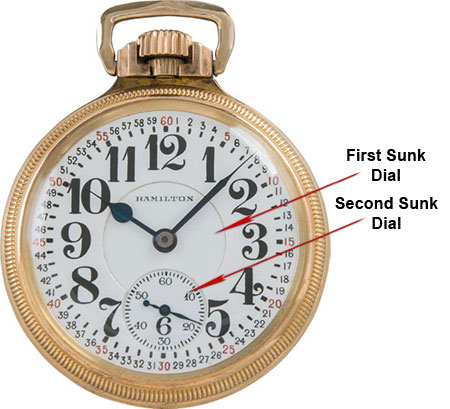The dial is the most identifying and conspicuous component of the pocket watch. Often referred to as the “face,” the dial is the smooth, typically white surface where artists hand paint numerals, markings, and occasionally images.

The process of making the dial begins with granulated enamel, which is placed on a metal plate (disk) equal to the size of the dial with a raised edge and then fired in order to form the glass-like appearance. This process is often repeated on both sides of the disk to improve the strength and rigidity of the dial. Despite this relatively straightforward process, watchmakers are able to create a great deal of variety in their dials by essentially layering different sections of the dial. This process is called sinking, and dials are either single-sunk, double-sunk, or very rarely, triple sunk. In order to single-sink a dial, the watchmaker must fire two dials in the fashion described above, the second being smaller and thinner than the first. The watchmaker then makes a hole the same size of the smaller dial in the larger and solders the former into the latter, creating a layered effect with crisp edges. In order for a watch to be double-sunk, this process must be repeated twice, with a total of three dials of varying size, thus producing three distinct layers. The cheaper – and easier – way to provide this effect is called pressing. Pressing is a simple matter of imprinting the desired layers of the dial (whether one or two) directly into the metal base prior to the introduction of the enamel. This allows the watchmaker to fire all layers of the dial simultaneously and can be distinguished from a genuinely sunk dial by the lack of distinct transitions between layers.
In some cases, pocket watch dials were manufactured wholly without the use of enamel. These watches sported an entirely metal dial which was then painted on directly. Due to the fact that enamel is prone to cracking, these all-metal dials were more durable than their enamel counterparts.
Source: http://theoldpocketwatch.com/creating-the-dial-by-craig-duling/
